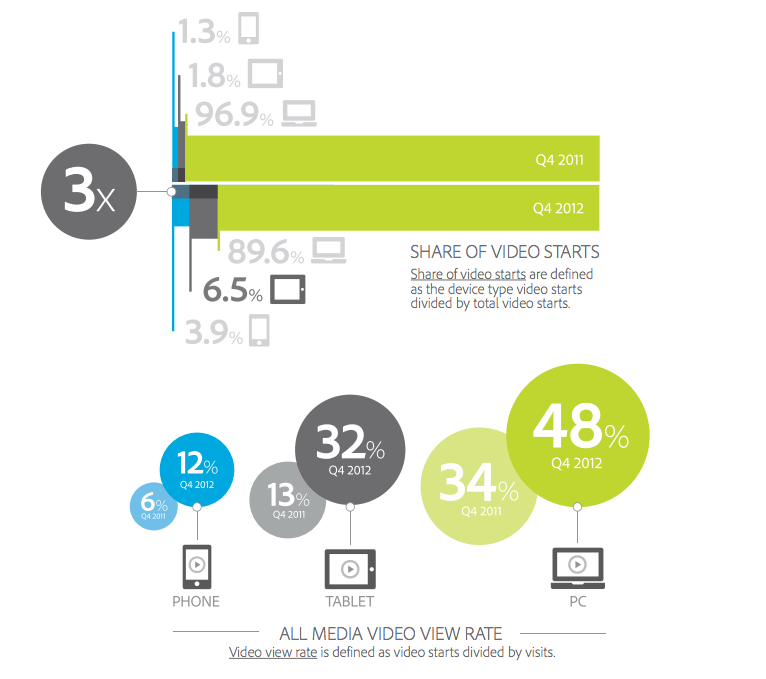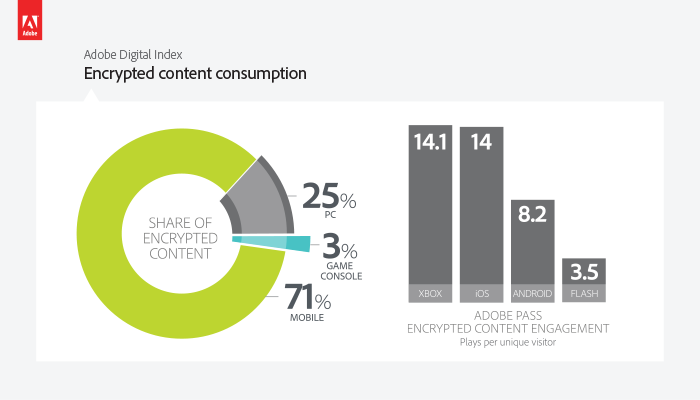Adobe has released its Digital Video Benchmark for the U.S. for 2012, wherein the Digital Index team shows what it learned monitoring video performance throughout the year across digital platforms. The study compiles data from Adobe Marketing Cloud customers, scoring viewing habits and also monitoring ad performance. 2012 saw a massive increase in mobile viewership, according to Adobe’s numbers, though desktop still dominates when it comes to online video.
Overall, digital video saw growth across all platforms, with an increase of 30 percent year over year in Q4 2012 versus the same time in 2012. TV and sports content was responsible for a large chunk of that new viewership, and streaming video available has grown 50 percent between Q1 2011 and Q4 2012. Smartphones and tablets were both among the biggest growth categories in terms of devices, and now account for more than 10 percent of all video starts combined, the first time they’ve reached that high of a share. Though both smartphone and tablet views have increased over the past couple of years, tablet viewing is accelerating at a faster rate and has already begun to pull away from phones.
 Tablet viewers are also much more likely to complete a video than viewers on a smartphone, or a PC, which is good news for content producers hoping for an attentive mobile audience. One of the challenges, however, comes in getting mobile viewers to engage with online ads, which will admittedly take some re-strategizing vs. approaches that have worked on the desktop.
Tablet viewers are also much more likely to complete a video than viewers on a smartphone, or a PC, which is good news for content producers hoping for an attentive mobile audience. One of the challenges, however, comes in getting mobile viewers to engage with online ads, which will admittedly take some re-strategizing vs. approaches that have worked on the desktop.
“There are two types of challenges with an increase in mobile viewing,” Adobe Senior Manager of Digital Index Tamara Gaffney explained in an interview. “One of them is a technology challenge, with enabling broadcasters and the media world to handle all the different platforms and formats and the ability to drive buying cycles around their inventory has been less developed up until now. That’s an area Adobe is working to fix.”
The other challenge comes in what kind of ad to present. Pre-roll ads are less likely to be successful on mobile platforms, especially for shorter video. Mid-roll and post-roll (which offers a click-through opportunity that can be very useful on mobile) look to present new opportunities, but there’s still probably some adapting to do in terms of finding a format that works best on tablets and smartphone devices, particularly for video clips that are under two minutes long.
A big opportunity for digital video in general comes from social channels, Adobe found. Social engagement jumped from 42 percent to 70 percent in terms of how likely referrals on networks like Facebook were to prompt a video viewing completion. Gaffney says that all media properties that employ video should be looking at ways to make better use of their social media channels, to offer video content to their followers and fans as much as possible to drive better video viewing engagement.
 Another area that Adobe monitors is authenticated streams, which it provides publishers through its TV Everywhere service. This allows publishers to gate access to their content to paying subscribers only. Adobe found that 71 percent of this access came from mobile devices, in a reversal of the situation with traditional digital video streams. The Xbox and iOS devices represent the highest engagement for this kind of content, with around 14 plays per unique visitor on both, with Android coming up third with just 8.2 plays per user.
Another area that Adobe monitors is authenticated streams, which it provides publishers through its TV Everywhere service. This allows publishers to gate access to their content to paying subscribers only. Adobe found that 71 percent of this access came from mobile devices, in a reversal of the situation with traditional digital video streams. The Xbox and iOS devices represent the highest engagement for this kind of content, with around 14 plays per unique visitor on both, with Android coming up third with just 8.2 plays per user.
Mobile is a fast-growing opportunity in digital video, and the good news for content providers is that viewers seem quite open to subscription-based models of video distribution on smartphones and tablets. Mobile is likely to become more, not less important to digital video, so it’ll be interesting to see how ad strategies change to reflect the growing impact of portable platforms.
